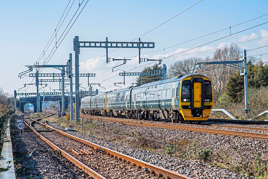What will commuting look like in southeast Wales by the end of the decade? If Transport for Wales (TfW) gets its way, there’ll be a big shift from relying on the overloaded M4, with travel by rail, bus and cycle becoming second nature.
Central to this are plans to open five new stations between Cardiff Central and Severn Tunnel Junction. They’ve been in the air for years, but TfW is pushing hard to make them a reality.
The proposals centre on improving services between Cardiff, Newport and Bristol by upgrading the four-track South Wales Main Line (SWML), so it can be used by more trains. For the first time, local commuting services could run frequently without disrupting express trains.
Government promises on funding rail infrastructure come and go (much like governments themselves). There are schemes the length and breadth of Britain clamouring for investment, and surely this ranks among the better ones.
For years, the biggest idea for improving transport in Wales’ most populous corner was a proposed £1.4 billion M4 relief link south of Newport. But as costs spiralled, the scheme was scrapped - to the delight of environmentalists and the dismay of hauliers.
Getting rid of it allowed minds to focus on the reality that rail, bus and ‘active travel’ networks don’t serve the range of journeys people are undertaking. (The M4 around Newport is said to be the UK’s fourth most congested urban motorway, and Cardiff the worst rail-connected major city.)
For many, rail trips from Newport and Cardiff aren’t time-competitive - often people find themselves driving to the city centre for a train that takes them out again and past where they live.
The idea for new stations was promoted by South East Wales Transport Commission, established in 2019 after the M4 relief plan was ditched. It made 58 recommendations, and its work was taken forward by commission chair Lord Burns. The Burns Delivery Board, created in 2021, secured £2.7 million from the Department for Transport to work up its scheme.
Plans have inched forward to the public consultation stage. “We’ve had 4,000 responses - more than expected, with a high level favouring the proposals,” says Dave McCallum, TfW’s strategic development programme manager.
Proposed new stops are at Cardiff East, Newport West, Somerton, Llanwern, and Magor and Undy.
Platforms are currently designed to be 170 metres long, allowing six- and eight-car trains to stop. Initial services are expected to be operated by three- and four-car trains.
There would be scope to run TfW’s light intercity and regional train (FLIRT) units, which have a low floor and level boarding between train and platform.
Proposals for new services between Cardiff, Bristol and Cheltenham Spa could offer the planned stations up to four trains per hour and increase frequencies at existing stations along the way.
All this should boost direct local and cross-border travel both sides of the Severn.
The ‘rail backbone’ would be supported by rapid bus and cycle corridors across the region, especially within Newport.
It’s claimed that over 90% of Cardiff and Newport’s population would live within a mile of a railway station or rapid bus corridor if all the proposals go ahead. TfW says many can be delivered through upgrades to the existing rail and road network.
Current services from Cardiff to Cheltenham are operated by TfW, which expects to run any new trains on that line, and from Cardiff to Bristol by Great Western Railway.
As the new services would be stopping trains, journey times would be longer between the two cities - just over an hour if travelling the full route. Existing service times would remain the same.
TfW expects to finish assessing public responses by the beginning of April.
“At this stage, it’s a concept before we move to the formal design stage,” says McCallum.
“Early consultation means you can amend the proposals as necessary.”
In railway planning speak, the project has reached Stage 2b - developing the outline business case and giving a clear picture of how it will help improve transport, health and wellbeing. It will also focus on affordability and assess whether resources will be available to complete the project.
“We’re having discussions with Network Rail and GWR to make sure the proposals fit together,” says McCallum.
He concedes there is limited extra capacity through the two-track Severn Tunnel, through which around 32,000 trains travel annually.
Last summer, it was refurbished with new track, sleepers and ballast. However, salt corrosion remains a constant problem, cutting the life expectancy of its infrastructure.
Tunnel aside, making the line four-track through Bristol East Junction, a major project completed in 2021, does offer real scope for extra services.
“Before that, the plan probably wouldn’t have been viable,” says McCallum.
“The business case is looking at the three-four trains per hour option. There are complications with additional services to Cheltenham because of capacity issues there; delivering that could take longer. In the immediate term, three trains would probably be more realistic.”
TfW is discussing funding the next step with DfT, the formal design stage and completing the full business case. McCallum estimates this process could cost more than £5m.
Photo: If Transport for Wales’ plans come to fruition, Magor and Undy, to the west of Severn Tunnel Junction, will become the site of a new station, replacing the original decades after that closed in 1964. GWR 158762 passes Magor on March 8 2021. JACK BOSKETT.
- A full version of this feature complete with a focus on the new stations appears in issue 1006 of RAIL. Get your copy delivered to your letterbox or inbox.
















Login to comment
Comments
No comments have been made yet.